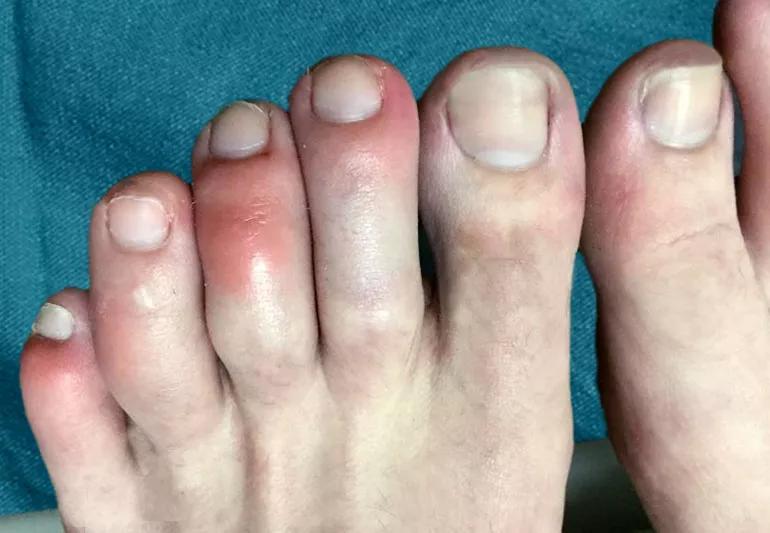Chilblain-like skin lesions and rashes probably aren’t COVID related

In the years since COVID-19 made its global debut, our vocabularies have expanded quite a bit. From plays on words like “flurona,” and new diagnoses like long COVID, to complex medical terminology (monoclonal antibodies, anybody?), we’ve become fluent in the language of the pandemic. But now that we’ve been living side-by-side with the virus long enough to gain an understanding of it, it’s time to reassess our glossary.
Advertisement
Cleveland Clinic is a non-profit academic medical center. Advertising on our site helps support our mission. We do not endorse non-Cleveland Clinic products or services. Policy
For instance: COVID toes. Are they really a thing? What about COVID rashes? And do these terms actually describe symptoms of COVID-19? We asked pediatric infectious disease specialist Frank Esper, MD.
By now, we’re all familiar with the telltale signs of a COVID-19 infection. But what about the disarming outliers? Should we be concerned?
Dr. Esper says while they’re attention-grabbing and unusual, COVID toes and COVID rashes are quite rare and aren’t signs of life-threatening complications. And while these symptoms have been associated with the coronavirus more than other viral infections, neither of them became widespread during the pandemic.
“These symptoms may be more common in COVID-19 compared with other viral infections,” Dr. Esper continues. “But they don’t affect a majority of people by any means.”
But what if it happens to you? Should you be worried?
Instead of seeing COVID toes or COVID rashes as a sign of danger, Dr. Esper says that we should see them as evidence that our bodies can react to infections in different ways. They may be interesting manifestations of our body’s response to the virus, but they’re nothing to worry about.
In the early days of the pandemic before home testing was possible, everybody was looking for new signs and symptoms to figure out if they were positive for COVID-19. In that context, COVID toes and COVID rashes seemed novel. But in reality, skin involvement isn’t unusual in the realm of viral infections.
Advertisement
Dr. Esper says it’s actually quite common for people to get rashes when they’re battling infections, especially viral respiratory ones.
“It’s not uncommon for someone to have a viral infection and have a rash or blotchy areas on their body,” he says. “This can happen with measles, for example. And medications sometimes cause skin rashes, too. So, there are a lot of reasons you may get a rash while battling a virus.”
The same goes for the reddish spots or lesions on the feet that we took to calling “COVID toes” in the early days of the pandemic. They aren’t new symptoms. And they can occur for a number of reasons.
“It’s possible that COVID toe is a skin reaction. It could also be caused by a small clog or micro clots in the blood vessels in the toes,” Dr. Esper explains. He’s seen something similar happen with ICU patients with sepsis and people on life support.
It’s a possibility, but it’s not the only explanation out there. In fact, many researchers now think COVID toes have nothing to do with COVID-19.
There’s a growing body of evidence to suggest that “COVID toe” was never really a thing.
That’s not to say that people’s toes weren’t inflamed or discolored. They were. But many doctors now believe they were just episodes of chilblains — painful patches of skin that occur in response to cold air exposure.
Researchers found a weak correlation between chilblain-style lesions and COVID-19 infection. While they didn’t rule out the possibility of a relationship between chilblains and COVID-19, they offered a few theories as to why incidences of chilblains might have gone up during the early days of the pandemic:
An article in Nature notes that — as COVID-19 has shifted from an acute crisis into a feature of our daily lives — rates of chilblains have pretty much gone back to normal.
The debate is still alive and well in scientific circles, but for everyday people, it doesn’t especially matter if COVID toes are real. Mercifully, we’re past the stage of the pandemic where we can’t be sure whether or not we’re infected.
If you’re concerned that you have COVID toes or a COVID rash, the first thing to do is to see if you have the virus. In countries where they’re available and affordable, most people use home tests to check for COVID-19. And those of us who are vaccinated (and boosted!) are unlikely to experience complications.
Advertisement
If you test positive for the virus, you should isolate at home. If you notice a rash or COVID toes in addition to the more common symptoms of the coronavirus, Dr. Esper says it’s best to contact your healthcare provider. They may prescribe medication to treat your skin and toes. And if your age or health status raises your risk for more severe complications, they may also decide to put you on an anti-viral medication like Paxlovid®.
Toes and rashes aside, you should call 911 or go to the nearest hospital if you have COVID-19 and:
COVID toe or no, all the basic rules of respiratory virus prevention still apply. If you’re sick, stay home. Wear a mask. When you are out, practice social distancing. And always, always, always wash your hands. Your skin will thank you!
Advertisement
Learn more about our editorial process.
Advertisement

Most can return to work or school when they’re symptom-free for 24 hours

Covering your mouth when you cough and staying home when you’re sick are a couple ways to help keep yourself and others COVID-free

This vital nutrient supports your health, but its role in COVID-19 prevention and treatment isn’t proven

Studies have shown promising results, but additional research is needed

Infection and inflammation can cause you to lose your voice and have other voice changes until you’re fully healed

A COVID-19 infection can bring on depression or anxiety months after physical symptoms go away

Just like the flu, COVID-19 continues to evolve every year with new and smarter variants

The latest omicron subvariants carry specific mutations that may allow the SARS-CoV-2 virus to be better at evading immune protection

Start having sex about 72 hours before ovulation, then at least every other day during your fertile window

Attachment theory suggests that your earliest relationships shape connections throughout your life

It isn’t a recognized mental health disorder, but research shows that problematic social media use can negatively affect your mental health, self-esteem and sleep